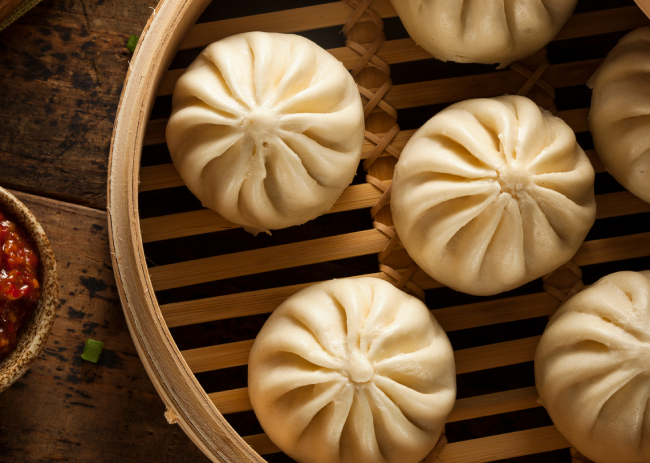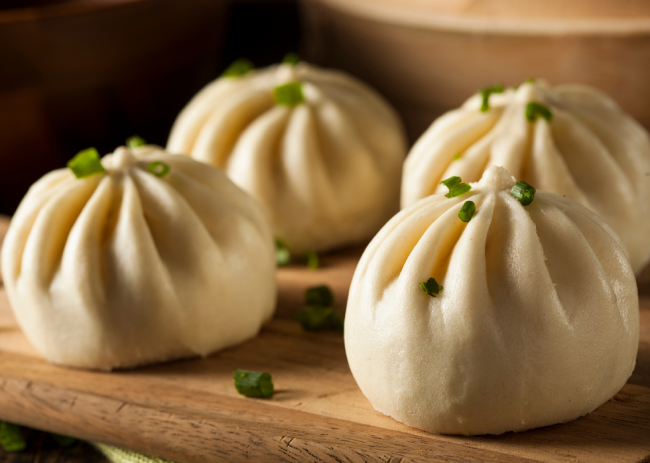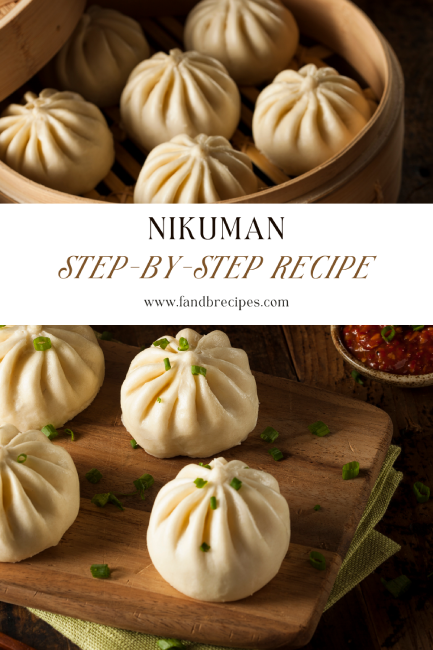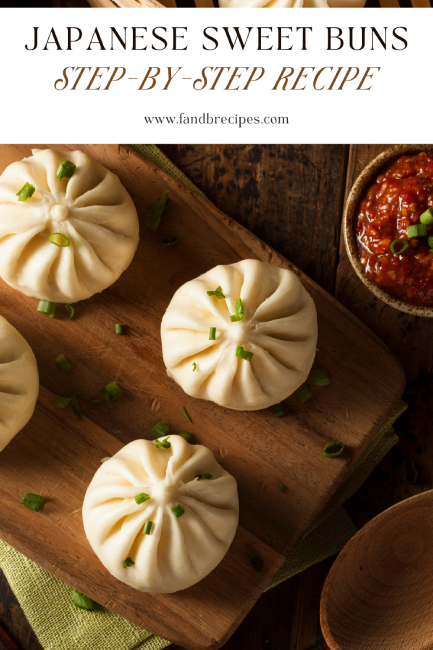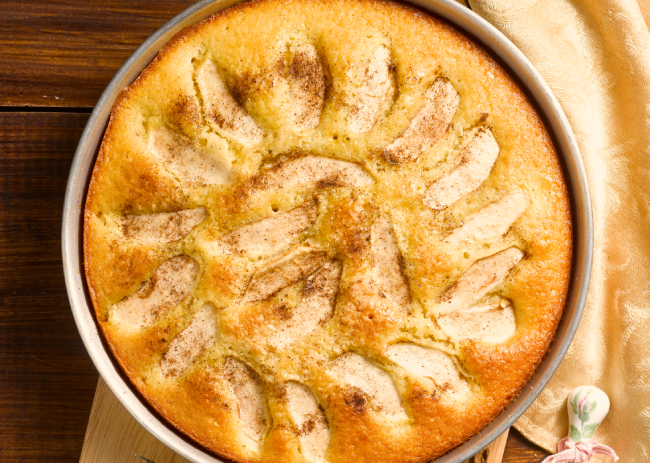Nikuman: Step-By-Step Recipe
Firstly, the delectable recipe for Nikuman is being presented. It highlights a beloved Japanese delicacy. Nikuman, known as steamed pork buns, is a savoury treat in Japan and around the world.
Additionally, the cooking process of Nikuman will be long. It ensures a successful outcome for anyone attempting this delectable dish.
Furthermore, the ingredients required to create the filling and soft dough will outline. It guides aspiring chefs through each step of the recipe.
It has a combination of tender and juicy pork, fragrant seasonings, and a fluffy steamed bun. Nikuman offers a delightful eating experience that is sure to meet any cravings.
Nikuman is a popular Japanese delicacy. It consists of steamed buns filled with a savoury pork filling. These delightful treats enjoy across Japan. It gained international recognition for its unique taste and texture.
What Is Nikuman?
The name “Nikuman” translates to “meat bun” in English. It accurately describes the key components of this dish. The bun itself has a soft and fluffy dough that steams to perfection, resulting in a light and airy texture.
The filling, made of seasoned ground pork, cooks until tender. It packs with flavourful ingredients such as onions, garlic, ginger, and soy sauce.
The mix of the tender bun and the pork filling creates a harmonious blend of flavours. It is both comforting and satisfying.
You can find Nikuman in various settings, from street food stalls to home-cooked meals. It enjoys as a quick snack or as part of a lunchbox, providing a convenient and delicious option for people on the go. The warmth and comforting nature of Nikuman make it particularly popular during colder seasons. It offers a delightful respite from the chilly weather.
The versatility of Nikuman extends beyond its traditional pork filling. Variations with fillings, such as beef, and chicken, emerged to cater to diverse preferences. This adaptability allows individuals to explore different flavours. It helps to find their personal favourite variation of this beloved dish.
Whether enjoyed as a snack, or a shared treat among friends and family, Nikuman secures its place as a beloved part of Japanese cuisine. Its mix of soft, steamed buns creates a delightful culinary experience. It continues to captivate taste buds around the world.
Why This Recipe Works
This recipe works for several reasons, each contributing to its success.
Firstly, the combination of selected ingredients plays a significant role. The tender and flavourful pork, marinated in a rich blend of seasonings, serve as the star of the dish. Additionally, the choice of vegetables, such as onions and garlic, enhances the taste.
Another factor contributing to the recipe’s success is the cooking method. The steaming process locks in the moisture, resulting in tender pork that melts in your mouth. Steaming also imparts a light and fluffy texture to the buns. It makes each bite a delightful experience.
Furthermore, the recipe’s clear instructions make it easy to cook. The detailed explanations help ensure that each component is. From the filling to the dough, prepares to perfection.
Lastly, the versatility of Nikuman adds to its appeal. Whether enjoyed as a snack, or crowd-pleasing party food, Nikuman never fails to impress. Its portable nature also makes it a great option for on-the-go meals or picnics.
In conclusion, the success of this recipe can attribute to the chosen ingredients. It includes the steaming cooking method, instructions, and the versatility of the dish. When combined, these elements create a delectable and enjoyable culinary experience. It is sure to delight both the cook and those fortunate enough to taste the flavourful Nikuman.
Ingredients Required to Make Nikuman
Here is the list of ingredients required to make Nikuman:
- 100 g Cake Flour: The recipe calls for 100 g of cake flour, which provides a soft and tender texture to the Nikuman dough.
- 50 g Bread Flour: Along with the cake flour, 50 g of bread flour helps to give the dough structure and strength. It results in a chewy and elastic texture.
- 2 ½ tsp Sugar: Adding 2 ½ tsp of sugar enhances the flavour of the Nikuman dough. It provides a subtle sweetness that balances the savoury filling.
- ¼ tsp Salt: A pinch of salt, around ¼ tsp, incorporates to enhance the flavour of the dough. It brings out the other seasonings in the filling.
- ¼ tsp Dry Yeast: ¼ tsp of dry yeast helps to activate the fermentation process in the dough. It helps it rise and achieve a fluffy texture.
- ½ tsp Baking Powder: ½ tsp of baking powder used in the dough mixture. It contributes to its light and airy consistency.
- 50 ml Water: Lukewarm water, around 50 ml, helps to hydrate the dough and activate the yeast. It ensures proper fermentation and a well-risen bun.
- 25 ml Milk: Whole milk, 25 ml, adds richness and a creamy texture to the dough. It results in a more flavourful and tender Nikuman.
- 100 g Ground Pork: The filling consists of 100 g of ground pork. It provides a savoury and meaty component to the Nikuman.
- 1 tsp Lard: 1 tsp of lard to enhance the richness and moisture of the pork filling, adding depth of flavour.
- 50 g Onion: Finely diced onion, weighing 50 g. This adds a sweet and aromatic element to the filling, enhancing all tastes.
- 50 g Boiled Bamboo Shoots: 50 g of boiled bamboo shoots, finely diced. It contributes a unique crunch and subtle earthy flavour to the filling.
- 30 g Shiitake Mushrooms: 30 g of shiitake mushrooms, finely diced. This provides an umami-rich taste and a meaty texture to the filling.
- 15 g Wood Ear Mushroom: Diced wood ear mushrooms, weighing 15 g. This adds a chewy and crunchy texture to the filling, enhancing its mouthfeel.
- 1 tsp Grated Ginger and Garlic: 1 tsp each of grated ginger and grated garlic, or ginger and garlic paste. This infuses the filling with a delightful aroma and a hint of spiciness.
- ½ tbsp Soy Sauce: ½ tbsp of soy sauce adds a savoury and salty taste to the filling. It helps in balancing the flavours and enhancing the umami profile.
- 1 tsp Oyster Sauce: 1 tsp of oyster sauce further enhances the savoury and umami notes in the filling. It helps in providing depth of flavour.
- 1 tsp Miso Paste: 1 tsp of Awase miso paste contributes a rich and complex taste to the filling. It helps in adding a hint of sweetness and saltiness.
- ½ tbsp Sesame Oil: ½ tbsp of sesame oil lends a nutty and aromatic flavour to the filling. It helps in enhancing its depth and richness.
- 1 tsp Black Vinegar: 1 tsp of black vinegar adds a tangy and slightly sweet note to the filling. It helps in providing a harmonious balance of flavours.
- ½ tbsp Sake: ½ tbsp of sake, a Japanese rice wine, adds a subtle sweetness and complexity to the filling. It helps in complementing the other seasonings.
- 1 tsp Sugar and Honey: 1 tsp each of sugar and honey bring a touch of sweetness to the filling. It helps in balancing the savoury flavours and adding a delightful contrast.
- Salt and White Pepper: A pinch of salt and white pepper enhances the seasoning of the filling. It helps in ensuring a well-balanced taste.
- 1 tsp Chinese Chicken Bouillon Powder: 1 tsp of Chinese chicken bouillon powder intensifies the savoury flavour. It helps in adding depth and complexity.
- 1 tbsp Slurry: A slurry made with 1 tbsp of cold water mixed with 1 tsp of potato starch helps thicken the filling. Also, it helps bind the ingredients together. It creates a cohesive texture.
Tools Required to Make Nikuman
To make Nikuman, you will need the following tools:
- Mixing Bowl: A mixing bowl is essential for combining the dough ingredients.
- Measuring Spoons and Cups: Accurate measurements are essential for a successful recipe. So having them on hand will help you part the ingredients.
- Cutting Board: A cutting board provides a stable surface for chopping the ingredients.
- Knife: A sharp knife helps in dicing the onions, bamboo shoots, and mushrooms.
- Grater: A grater is useful for grating ginger and garlic. It helps in ensuring they mince and release their flavours into the filling.
- Mixing Utensils: You’ll need utensils such as a spoon or spatula to mix the ingredients. It helps in ensuring they are even incorporated.
- Stovetop or Cooktop: A stovetop or cooktop helps to cook the filling mixture. It helps in allowing the flavours to meld together and ensuring the pork is cooked.
- Skillet or Pan: A skillet or pan helps to sauté the filling ingredients. It helps in allowing them to soften and develop their flavours.
- Rolling Pin: A rolling pin helps to flatten and shape the Nikuman dough. It helps in creating the perfect thickness for the buns.
- Steamer: A steamer is essential for cooking the Nikuman. It provides gentle and even heat to steam the buns until they become fluffy and cooked through.
- Parchment Paper or Steaming Liners: These are optional. But can help to line the steamer or prevent the Nikuman from sticking during the process.
- Serving Tray or Plate: Once cooked, the Nikuman can arrange on a serving tray or plate for serving.
- Tongs or Spatula: Tongs or a spatula can be handy for removing the steamed Nikuman from the steamer.
Nikuman Recipe
Learn how to make fluffy and soft Nikuman (Japanese steamed pork buns) from scratch with a flavourful vegetable and pork filling.
Servings: 4 buns Prep Time: 30 minutes Cook Time: 20 minutes Total Time: 50 minutes Calories: 251.8 kcal Course: Appetizer, Snack Cuisine: Japanese/Chinese
Having these tools ready will ensure a smooth process as you make delicious Nikuman at home.
Take a jug and add 50 ml of water. Stir in 2 ½ tsp of sugar and ¼ tsp of dry yeast, and let it activate for a few minutes until foamy.
In a bowl, sift together 100 g of cake flour and 50 g of bread flour. Add ¼ tsp of salt and ½ tsp of baking powder. Mix the ingredients well until they are even distributed.
After that, Pour the contents of the jug into the bowl, including the foam, and add 25 ml of milk. Mix until a rough dough forms.
Transfer the dough onto a lightly floured surface and knead it until smooth. It should take about 5 minutes.
Return the dough to the bowl and cover it with cling film. Allow it to rest in a warm place until it doubles in size. It takes 40-90 minutes depending on the environment.
For the filling, heat a pan over medium heat and add ½ tbsp of sesame oil. Add the diced onion, boiled bamboo shoots, shiitake mushrooms, wood ear mushrooms, grated ginger, and grated garlic to the pan. Fry them for 1-2 minutes.
Next, add ½ tbsp of soy sauce, 1 tsp of oyster sauce, 1 tsp of miso paste, 1 tsp of black vinegar, ½ tbsp of sake, and 1 tsp of sugar. Also, add 1 tsp of honey, a pinch of salt, a pinch of white pepper, and 1 tsp of Chinese chicken bouillon powder. Mix the ingredients well. Continue cooking until the liquid absorbs and disappears into the mixture.
Prepare a slurry by mixing 1 tbsp of cold water with 1 tsp of potato starch in a small bowl. Turn off the heat and pour the slurry into the pan. Stir the mixture over the residual heat until it becomes glossy and thick.
Transfer the filling to a container and allow it to cool. Once it is cool to the touch, mix in 100 g of ground pork and 1 tsp of lard. Cover the container with plastic wrap and chill it in the fridge until the dough is ready.
Once the dough has doubled in size, gently press out the air and roll it into a cylinder. Cut the dough into equal pieces, each weighing approximately 60g (2oz).
Shape each piece into a round disc shape, cover it with cling film or a clean damp cloth, and let it rest for 15 minutes.
Take the filling out of the fridge. Divide it into portions weighing approximately 60g (2oz) for each wrapper.
Place each ball of dough on a chopping board and flatten it with your palm. Then, use a rolling pin to thin out the edges. The centre should be about 5mm (¼ inch) thick, while the edges should be about 2mm thick.
Roll a part of the filling and place it in the centre of the dough. Bring the top and bottom edges to the middle and pinch them together. Repeat the same process with the left and right edges, and then with each pair of parallel corners. Finally, pinch the middle and twist to close the Nikuman.
Place each completed Nikuman on an individual square of baking paper. Arrange them in the steaming basket. Ensure that there is enough space between each Nikuman and the edges of the basket.
Cover the steaming basket with a lid and let it rest for 15 minutes for the second rise.
After 15 minutes, fill the steamer with cold water and place the steaming basket with the Nikuman on top. Put the steamer on the stove and bring it to a boil over high heat. Once it starts boiling, set a timer for 13 minutes.
Remove the lid from the steamer and enjoy your delicious Nikuman.
Nikuman: Nutritional Information
Calories: 251.8kcal
Carbohydrates: 37.4g
Protein: 10g
Fat: 7.9g
Saturated Fat: 2.5g
Polyunsaturated Fat: 1.6g
Cholesterol: 20.5mg
Sodium: 663.8mg
Fiber: 2.2g
Tips To Make The Best Nikuman
- Use lukewarm water: When activating the yeast, ensure that the water is lukewarm. It helps to promote proper yeast fermentation and activation. This will help the dough rise.
- Knead the dough: Take the time to knead the dough until it becomes smooth. This process helps develop gluten. It results in a more elastic and chewy texture for the Nikuman.
- Allow proper resting time: Let the dough rest in a warm place until it doubles in size. This step is crucial for achieving a light and fluffy texture in the final product. The resting time allows the yeast to continue fermenting and producing carbon dioxide. This causes the dough to rise.
- Dice the filling ingredients: Ensure that the onion, boiled bamboo shoots, mushrooms, and wood ear mushrooms are diced. This ensures an even distribution of flavours throughout the filling. It makes it easier to assemble the Nikuman.
- Cook the filling until the liquid is absorbed: Make sure to continue cooking until the liquid absorbs into the ingredients. This ensures a rich and concentrated flavour in the filling.
- Chill the filling before use: Cooling the filling in the fridge helps it firm up. It makes it easier to handle and assemble the Nikuman. The chilled filling also prevents it from oozing out during the steaming process.
- Thin out the dough edges: When rolling out the dough, ensure that the centre is thicker and the edges are thinner. This allows for a balanced texture when biting into the Nikuman.
- Seal the Nikuman: Take care to seal the Nikuman tight by pinching and twisting the dough in the centre. This ensures that the filling stays inside during steaming.
- Give enough space between Nikuman: When placing the Nikuman in the basket, make sure to leave enough space between the edges of the basket. This allows for even steaming and prevents them from sticking together.
- Steam until cooked: Follow the steaming time of 13 minutes or until the Nikuman cooks. Overcooking can result in a dry texture, while undercooking may leave the dough raw.
By following these tips, you’ll be able to create Nikuman that are fluffy, and enjoyable to eat.
Storing & Freezing
To store Nikuman, allow them to cool completely at room temperature. Once cooled, place them in an airtight container or resealable bag. Store in the refrigerator for up to 3 days to maintain their freshness.
If you want to freeze Nikuman for later consumption, it’s best to freeze them before steaming. Place the assembled but uncooked Nikuman on a baking sheet lined with parchment paper. It makes sure they are not touching each other. Place the baking sheet in the freezer and allow the Nikuman to freeze until solid.
Once frozen, transfer the Nikuman to a freezer-safe bag or container. Make sure to remove any excess air to prevent freezer burn. The frozen Nikuman can store in the freezer for up to 2 months.
When you’re ready to enjoy the frozen Nikuman, simply steam them from the frozen. Place the frozen Nikuman in a steamer basket. Cover it with a lid, and steam for about 15-20 minutes or until heated through.
Proper storing and freezing Nikuman allows you to enjoy this snack at your ease.
FAQs
What Is Nikuman In Japanese?
In Japanese cuisine, “Nikuman” is a popular and beloved dish that often enjoy as a snack or light meal. The term “Nikuman” translates to “meat bun” in English. “Niku” means meat and “Man” refers to the bun-like shape. These delectable buns consist of fluffy and steamed dough. It is filled with a savoury mixture of seasoned ground pork and various vegetables. Nikuman is a staple in convenience stores, food stalls, and households throughout Japan.
Is A Pork Bun Japanese Or Chinese?
The pork bun, also known as “Nikuman” in Japanese and “baozi” in Chinese, is a popular culinary delight. You can find it in both Japanese and Chinese cuisines. it often debates which culture can lay claim to its origins. But the pork bun has become a beloved dish in both countries. These steamed or baked buns are filled with a savoury mixture of pork and various spices.
It helps in creating a delicious and satisfying treat. The soft and fluffy bun serves as the perfect vessel for the flavourful pork filling. It results in a mouthwatering combination of textures and tastes.
Whether enjoyed as a quick snack, street food, or part of a larger meal, the pork bun has transcended borders. It has become a beloved culinary symbol of both Japanese and Chinese cuisines.
How Much Is Nikuman In Japan?
In Japan, the price of Nikuman, a popular steamed bun filled with meat or vegetables, ranges from 150 to 300 yen. This tasty and satisfying street food snack, you can find in various locations. This includes convenience stores, food stalls, and specialized Nikuman shops. The price may vary depending on the size, ingredients, and the specific establishment. Yet, on average, you can expect to pay within the above price range for a delicious Nikuman in Japan.
What Are The Meat Buns From Haikyuu?
In the anime series Haikyuu! The characters indulge in various meat buns that are showcased throughout the show. One of the most notable meat buns is called the “Karasuno Meat Bun.” This delight is often seen devoured by the members of the Karasuno High School volleyball team. They consider it a favourite snack during their training and matches.
The Karasuno Meat Bun depict as a steamed bun filled with a mixture of ground meat, vegetables, and spices. Its aroma and taste make it a tempting treat for the characters. And fans of the show are often left craving this fictional culinary creation.
Alongside this Bun, other meat bun variations may also make an appearance in the series. They help in providing gastronomic delights for both the characters and viewers alike.
What Is The History Of Nikuman?
Nikuman, a beloved staple of Japanese cuisine, has its roots in ancient China. The history of Nikuman can trace back to the Tang Dynasty (618-907 AD) in China. During this period, Chinese traders introduced steamed buns, known as “baozi,” to Japan. These buns were filled with ingredients such as meat, vegetables, or sweet fillings.
Over time, the Japanese adapted and localized the concept of steamed buns. It gives rise to Nikuman. The term “Nikuman” itself translates to “meat bun” in Japanese. It helps in reflecting its most common filling. Nikuman gained popularity in Japan during the Meiji period (1868-1912). It happened when international trade brought new culinary trends to the country.
Nikuman was a luxury food item reserved for special occasions or enjoyed by the elite. Yet, as Japan underwent industrialization, Nikuman became more accessible to the general population. It transformed into a popular street food, sold at food stalls, and train stations.
What Is Bun Bun In Chinese?
In Chinese, “bun bun” is not a specific term or phrase. But, if you are referring to the word “bun” in Chinese cuisine, it is commonly known as “baozi” or “mantou.” These terms help to describe various types of steamed buns with different fillings.
In Conclusion
Making Nikuman is a delightful culinary adventure. It allows you to create these delicious meat-filled steamed buns in the kitchen. By following the simple steps of preparing the dough. You can enjoy the mouthwatering satisfaction of homemade Nikuman.
Whether you choose to savour them as a quick snack or a meal, Nikuman is sure to impress with its soft texture mixed with savoury fillings.
So roll up your sleeves, and embark on the journey of creating your own delectable Nikuman. Experience the authentic flavours of this beloved Japanese delicacy.

Nikuman: Step-By-Step Recipe
Ingredients
- 100 g Cake Flour
- 50 g Bread Flour
- 2½ tsp Sugar
- ¼ tsp Salt
- ¼ tsp Dry Yeast
- ½ tsp Baking Powder
- 50 ml Water
- 25 ml Milk
- 100 g Ground Pork
- 1 tsp Lard
- 50 g Onion Finely diced
- 50 g Bamboo Shoots Boiled
- 30 g Shiitake Mushrooms Finely diced
- 15 g Wood Ear Mushroom Diced
- 1 tsp Ginger Grated
- 1 tsp Garlic Grated
- ½ tbsp Soy Sauce
- 1 tsp Oyster Sauce
- 1 tsp Miso Paste
- ½ tbsp Sesame Oil
- 1 tsp Black Vinegar
- ½ tbsp Sake
- 1 tsp Sugar
- 1 tsp Honey
- Salt to taste
- White Pepper to taste
- 1 tsp Chinese Chicken Bouillon Powder
- 1 tbsp Slurry
Instructions
- Take a jug and add 50 ml of water. Stir in 2 ½ tsp of sugar and ¼ tsp of dry yeast, and let it activate for a few minutes until foamy.
- In a bowl, sift together 100 g of cake flour and 50 g of bread flour. Add ¼ tsp of salt and ½ tsp of baking powder. Mix the ingredients well until they are even distributed.
- After that, Pour the contents of the jug into the bowl, including the foam, and add 25 ml of milk. Mix until a rough dough forms.
- Transfer the dough onto a lightly floured surface and knead it until smooth. It should take about 5 minutes.
- Return the dough to the bowl and cover it with cling film. Allow it to rest in a warm place until it doubles in size. It takes 40-90 minutes depending on the environment.
- For the filling, heat a pan over medium heat and add ½ tbsp of sesame oil. Add the diced onion, boiled bamboo shoots, shiitake mushrooms, wood ear mushrooms, grated ginger, and grated garlic to the pan. Fry them for 1-2 minutes.
- Next, add ½ tbsp of soy sauce, 1 tsp of oyster sauce, 1 tsp of miso paste, 1 tsp of black vinegar, ½ tbsp of sake, and 1 tsp of sugar. Also, add 1 tsp of honey, a pinch of salt, a pinch of white pepper, and 1 tsp of Chinese chicken bouillon powder. Mix the ingredients well. Continue cooking until the liquid absorbs and disappears into the mixture.
- Prepare a slurry by mixing 1 tbsp of cold water with 1 tsp of potato starch in a small bowl. Turn off the heat and pour the slurry into the pan. Stir the mixture over the residual heat until it becomes glossy and thick.
- Transfer the filling to a container and allow it to cool. Once it is cool to the touch, mix in 100 g of ground pork and 1 tsp of lard. Cover the container with plastic wrap and chill it in the fridge until the dough is ready.
- Once the dough has doubled in size, gently press out the air and roll it into a cylinder. Cut the dough into equal pieces, each weighing approximately 60g (2oz).
- Shape each piece into a round disc shape, cover it with cling film or a clean damp cloth, and let it rest for 15 minutes.
- Take the filling out of the fridge. Divide it into portions weighing approximately 60g (2oz) for each wrapper.
- Place each ball of dough on a chopping board and flatten it with your palm. Then, use a rolling pin to thin out the edges. The centre should be about 5mm (¼ inch) thick, while the edges should be about 2mm thick.
- Roll a part of the filling and place it in the centre of the dough. Bring the top and bottom edges to the middle and pinch them together. Repeat the same process with the left and right edges, and then with each pair of parallel corners. Finally, pinch the middle and twist to close the Nikuman.
- Place each completed Nikuman on an individual square of baking paper. Arrange them in the steaming basket. Ensure that there is enough space between each Nikuman and the edges of the basket.
- Cover the steaming basket with a lid and let it rest for 15 minutes for the second rise.
- After 15 minutes, fill the steamer with cold water and place the steaming basket with the Nikuman on top. Put the steamer on the stove and bring it to a boil over high heat. Once it starts boiling, set a timer for 13 minutes.
- Remove the lid from the steamer and enjoy your delicious Nikuman.
Notes
- Use lukewarm water: When activating the yeast, ensure that the water is lukewarm. It helps to promote proper yeast fermentation and activation. This will help the dough rise.
- Knead the dough: Take the time to knead the dough until it becomes smooth. This process helps develop gluten. It results in a more elastic and chewy texture for the Nikuman.
- Allow proper resting time: Let the dough rest in a warm place until it doubles in size. This step is crucial for achieving a light and fluffy texture in the final product. The resting time allows the yeast to continue fermenting and producing carbon dioxide. This causes the dough to rise.
- Dice the filling ingredients: Ensure that the onion, boiled bamboo shoots, mushrooms, and wood ear mushrooms are diced. This ensures an even distribution of flavours throughout the filling. It makes it easier to assemble the Nikuman.
- Cook the filling until the liquid is absorbed: Make sure to continue cooking until the liquid absorbs into the ingredients. This ensures a rich and concentrated flavour in the filling.
- Chill the filling before use: Cooling the filling in the fridge helps it firm up. It makes it easier to handle and assemble the Nikuman. The chilled filling also prevents it from oozing out during the steaming process.
- Thin out the dough edges: When rolling out the dough, ensure that the centre is thicker and the edges are thinner. This allows for a balanced texture when biting into the Nikuman.
- Seal the Nikuman: Take care to seal the Nikuman tight by pinching and twisting the dough in the centre. This ensures that the filling stays inside during steaming.
- Give enough space between Nikuman: When placing the Nikuman in the basket, make sure to leave enough space between the edges of the basket. This allows for even steaming and prevents them from sticking together.
- Steam until cooked: Follow the steaming time of 13 minutes or until the Nikuman cooks. Overcooking can result in a dry texture, while undercooking may leave the dough raw.

